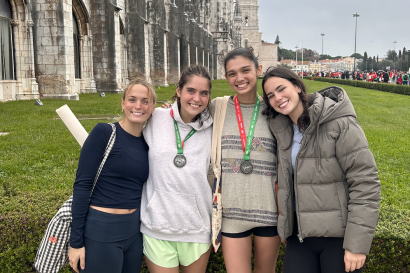
One of the things I have loved the most about my study abroad experience are the program trips organized by my center. Usually these are day trips to nearby locations in Spain that allow us to get to know Andalucía and better understand its rich and varied history. However, my absolute favorite was to Morocco—in the span of five days we visited six towns, stayed with host families, ate amazing food, rode camels, and spent time gazing over the Atlantic and the Mediterranean. We talked to local organizations about immigration and women’s rights, hung out with local teenagers in Rabat, drank avocado juice (a-ma-zi-ng!) in sidewalk cafes, and had a picnic lunch in the Rif Mountains. While people always talk about traveling easily within Europe while studying abroad, studying in southern Spain has the added plus of being very close to Africa. From Granada it's only about 2.5 hours to the the cities of Tarifa or Algeciras and from there a short ferry ride (less than two hours) until suddenly you find yourself stepping foot in Tangier. From there high speed rails can connect you with the key metropolises of Fez, Casablanca, and Rabat.
That being said, visiting Morocco was one of the most intense experiences of my life. I had experienced some cultural shock my first few weeks in Spain, but suddenly in the middle of Rabat—more intensely than ever—I became acutely aware of how far away I was from home. The architecture and narrow roads were vaguely recognizable from the narrow cobblestone pathways of the Albaicín neighborhood of Granada, but suddenly they were everywhere. Streets were bustling with people speaking in a language I didn't understand, signs were written in a beautiful script that to me imparted no information, and out over the city the horizon seemed endless. The first day I found myself overwhelmed by the sheer quantity of new sounds and sensations. Yet, very quickly, I found myself adapting. Food was distinctive and delicious—steaming tagines and five different types of bread for breakfast. Bright colors and patterns covered the walls and flooded the crowded marketplaces. Staying with host families with two other students, we used hand gestures, noises, and facial expressions to express our amazement at the huge plates of couscous our host mom cooked up for us and the delicious moroccan tea she poured—always raising her arm around a foot and a half above the glass as she did in order to aerate it. Even without a shared language—most people spoke Moroccan Arabic or French—we managed to communicate with the people we met whether non-verbally or with the help of a translator. By the second morning in Chefchaouen I could easily navigate the windy market streets to find my way back to our hostel.
Each day in Morocco, I learned so much simply by observing the everyday life taking place around me. Yet, each day I also learned so much about my own capacity to connect with and thoughtfully engage a culture distinct from my own. This video is a mixture of clips from my time spent in Morocco this semester (I was lucky enough to visit for another weekend when my family visited me in Granada). I hope it offers even a little sneak peek into the wonder I experienced.
[soundtrack: “Você Sabe” by Sargasso]









